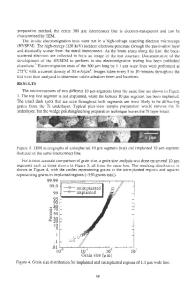Electromigration Reliability of Electroplated Gold Interconnects
- PDF / 874,501 Bytes
- 6 Pages / 612 x 792 pts (letter) Page_size
- 59 Downloads / 521 Views
Electromigration Reliability of Electroplated Gold Interconnects Steve H. Kilgore1, 2 and Dieter K. Schroder3 1 Freescale Semiconductor, Inc., Tempe, AZ 85284, USA 2 Material Science and Engineering, Arizona State University, Tempe, AZ 85287, USA 3 Electrical Engineering, Arizona State University, Tempe, AZ 85287, USA ABSTRACT The electromigration lifetimes of a very large quantity of passivated electroplated Au interconnects were measured utilizing high-resolution in-situ resistance monitoring equipment. Application of moderate accelerated stress conditions with current density limited to 2 MA/cm2 and oven temperatures in the range of 300°C to 375°C prevented large Joule-heated temperature gradients and electrical overstress failures. A Joule-heated Au film temperature increase of 10°C on average was determined from measured temperature coefficients of resistance (TCRs). A failure criterion of 50% resistance degradation was selected to avoid thermal runaway and catastrophic open circuit failures. All Au lifetime distributions followed log-normal statistics. An activation energy of 0.80 ± 0.05 eV was measured from constant-current electromigration tests at multiple temperatures. A current density exponent of 1.91 ± 0.03 was extracted from multiple current densities at a single constant temperature. INTRODUCTION Electromigration in metal interconnects is the most pernicious failure mechanism in semiconductor integrated circuits (ICs). Continual miniaturization of IC dimensions has resulted in correspondingly higher current densities and operating temperatures on metal interconnects for which long-term electromigration reliability has become a primary concern. An abundance of investigations on electromigration have been concentrated on aluminum (Al) interconnects and more recently copper (Cu) interconnects for silicon-based ICs [1-3]. An alternative metallization compatible with gallium arsenide (GaAs) was required in the development of highpowered radio frequency (RF) compound semiconductor devices operating at higher current densities and elevated temperatures. Gold-based metallizations were implemented on GaAs devices due to the unique formation of a very low resistance ohmic contact as well as the superior electrical and thermal conductivity properties of gold (Au). Another advantage of Au metallization is its termination into Au bond pads that eliminates the packaging reliability problem of AuAl2 intermetallic “purple plague” formation observed with Al bond pads and Au wire bonds at elevated temperatures [4]. In addition to the vital role of Au films on GaAs devices for ohmic contacts, Au interconnects are expected to have improved electromigration reliability due to its higher melting point. However, published investigations on electromigration reliability of passivated electroplated Au interconnects are both scarce and inadequate [5, 6]. The objective of this investigation was to accurately measure electromigration model parameters for passivated Au interconnects from statistically rigorous and precisely contro
Data Loading...











